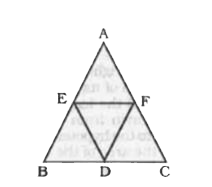If D, E and F are the mid points of BC, CA and AB respectively of the △ABC then the ratio of aria parallelogram DEFB and area of the trapezium CAFD is ,
2:3
3:4
1:2
1:3
The correct Answer is:A
To find the ratio of the area of parallelogram DEFB to the area of trapezium CAFD in triangle ABC, we can follow these steps:
Step 1: Understand the Triangle and Midpoints
Let triangle ABC have vertices A, B, and C. The midpoints of sides BC, CA, and AB are D, E, and F respectively.
Step 2: Identify Areas of Smaller Shapes
When we connect the midpoints, we form smaller triangles and a parallelogram within triangle ABC. The triangles formed are AEF, BDF, and CDE. The area of triangle ABC can be divided into four smaller areas: triangle AEF, triangle BDF, triangle CDE, and parallelogram DEFB.
Step 3: Calculate Areas of Smaller Triangles
Since D, E, and F are midpoints, each of the triangles AEF, BDF, and CDE will have equal areas. Let the area of each of these triangles be x. Therefore, the area of triangle ABC is:
Area of ABC=AEF+BDF+CDE=x+x+x=3x
Step 4: Area of Parallelogram DEFB
The area of parallelogram DEFB can be calculated as follows:
Area of DEFB=Area of ABC−(Area of AEF+Area of CDE)=3x−(x+x)=3x−2x=x
Step 5: Area of Trapezium CAFD
The area of trapezium CAFD can be calculated as:
Area of CAFD=Area of ABC−Area of BDF=3x−x=2x
Step 6: Calculate the Ratio
Now, we can find the ratio of the area of parallelogram DEFB to the area of trapezium CAFD:
Ratio=Area of DEFBArea of CAFD=x2x=12
Conclusion
Thus, the ratio of the area of parallelogram DEFB to the area of trapezium CAFD is 12.
Let triangle ABC have vertices A, B, and C. The midpoints of sides BC, CA, and AB are D, E, and F respectively.
When we connect the midpoints, we form smaller triangles and a parallelogram within triangle ABC. The triangles formed are AEF, BDF, and CDE. The area of triangle ABC can be divided into four smaller areas: triangle AEF, triangle BDF, triangle CDE, and parallelogram DEFB.
Since D, E, and F are midpoints, each of the triangles AEF, BDF, and CDE will have equal areas. Let the area of each of these triangles be x. Therefore, the area of triangle ABC is:
Area of ABC=AEF+BDF+CDE=x+x+x=3x
The area of parallelogram DEFB can be calculated as follows:
Area of DEFB=Area of ABC−(Area of AEF+Area of CDE)=3x−(x+x)=3x−2x=x
The area of trapezium CAFD can be calculated as:
Area of CAFD=Area of ABC−Area of BDF=3x−x=2x
Now, we can find the ratio of the area of parallelogram DEFB to the area of trapezium CAFD:
Ratio=Area of DEFBArea of CAFD=x2x=12
Thus, the ratio of the area of parallelogram DEFB to the area of trapezium CAFD is 12.
Similar Questions
Knowledge Check
- Question 1 - Select One
If D, E and Fare the mid points of BC, CA and AB respectively of the ABC then the ratio of area of the parallelogram DEFB and area of the trapezlum CAFD is:
A2:3B3:4C1:2D1:3 - Question 2 - Select One
If D, E and F are the mid-points of sides BC, CA and AB respectively of △ABC, then the ratio of the areas of △DEF to the area of △ABC is :
A1:4B1:2C1:3D2:3 - Question 3 - Select One
If D, E and Fare the mid points of BC, CA and AB respectively of the ABC then the ratio of area of the parallelogram DEFB and area of the trapezlum CAFD is:
A1:2B2:3C3:4D1:1
If D, E and F are the mid-points of the sides of an equilateral triangle ABC, then the ratio of the area of triangle DEF and DCF is :
 View Solution
View SolutionIn the adjoining figure D, E and F are the mid-points of the sides BC, CA and AB respectively of ΔABC. Prove that:
(i) □BDEF is a parallelogram
(ii) area of ΔDEF=14× area of ΔABC
(iii) area of □BDEF=12× area of ΔABC
 View Solution
View SolutionIf D, E and F be the middle points of the sides BC,CA and AB of the ΔABC, then AD+BE+CF is
View SolutionIf D,E,F are the mid-points of the sides BC, Ca and AB respectively of a triangle ABC, prove by vector method that Area of ΔDEF = 1/4 Area of ΔABC
View SolutionLet D, E and F be the middle points of the sides BC,CA and AB respectively of a triangle ABC. Then, AD + BE + CF equals to
View Solution

